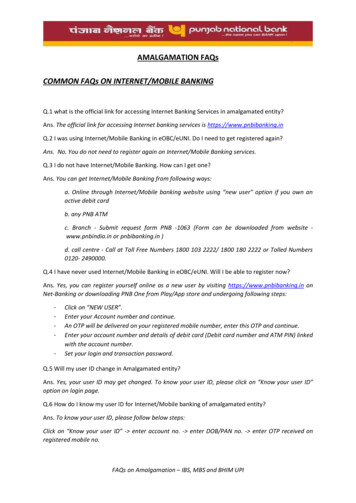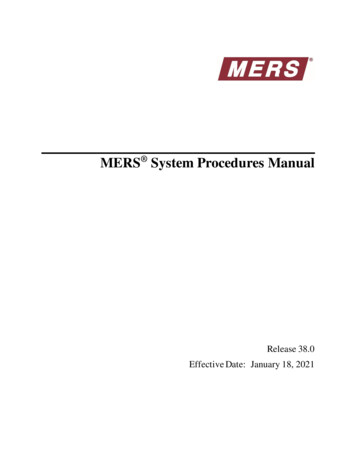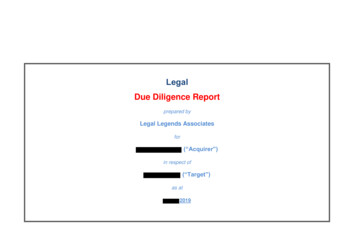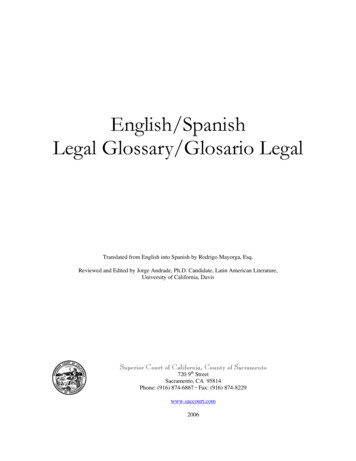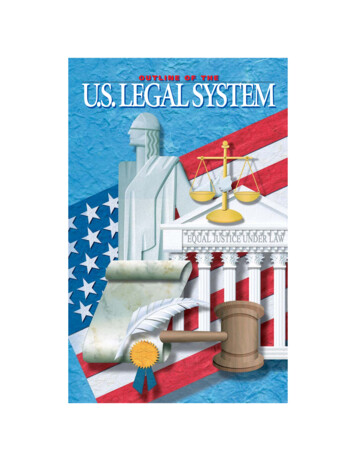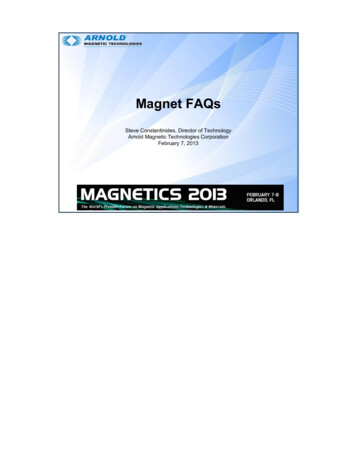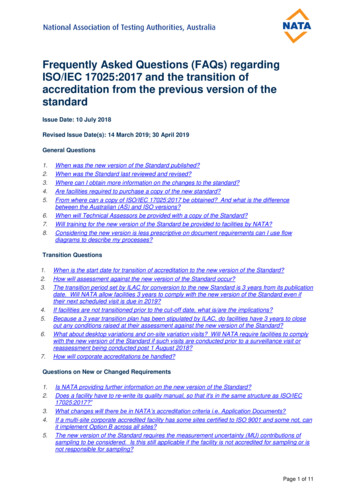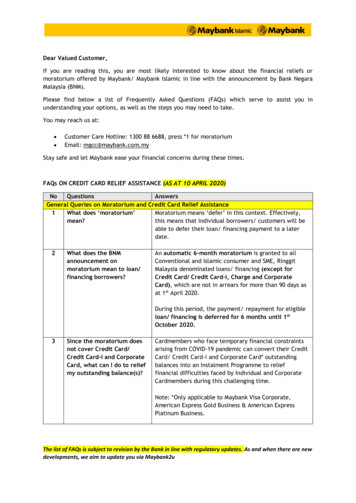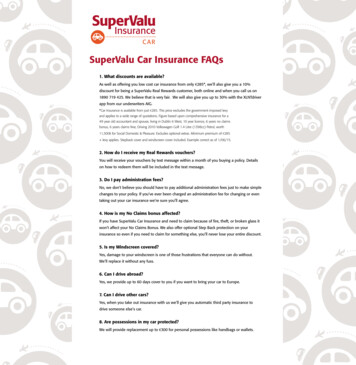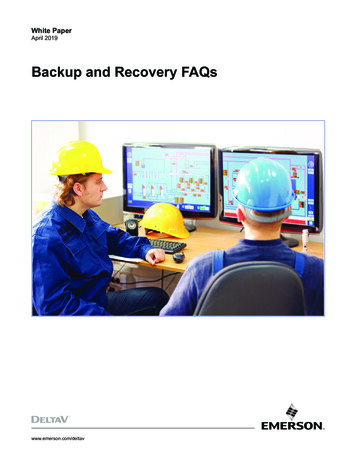![MERS Legal FAQs[1]](/img/11/mers-20legal.jpg)
Transcription
MERS LEGAL FAQsTABLE OF CONTENTSI. INTRODUCTION TO MERS .1II. MERS SYSTEM OVERVIEW.10III. CERTIFYING OFFICERS .12IV. TITLE COMPANIES .14V. PAYOFF & LIEN RELEASES .16VI. FORECLOSURES .20VII. BANKRUPTCY .37VIII. SERVICE OF PROCESS .39IX. SUBPOENAS.43X. USING MOM DOCUMENTS IN ERROR .45XI. STATE SPECIFIC ISSUES .46a)b)c)d)e)f)g)h)i)CALIFORNIA MORTGAGEE ASSIGNMENTCOLORADOi) FHA Number and Lost Note AffidavitNEW YORKi) CEMAMASSACHUSETTS VOTEMINNESOTA LIEN RELEASESNORTH CAROLINA LIEN RELEASESNORTH CAROLINA FORECLOSURESLOUISIANA FORECLOSURESPENNSYLVANIA (Revenue Ruling, Assignment of Credit Bid)XII. STATE QUALIFICATION AND LICENSING .56XIII. CO-OPS .58XIV. MANUFACTURED HOUSING.59XV. SUFFOLK COUNTY, NEW YORK LITIGATION .60XVI. MERS COMMERCIAL .64XVII. MERS E-REGISTRY .70
I. INTRODUCTION TO MERSWhat is MERS?History:While it may appear that MERS in the last few years is everywhere, it does have a good bit ofhistory behind it. In 1991 an Inter Agency Technology Task Force (IAT) comprised ofrepresentatives from Mortgage Bankers Association (MBA), Fannie Mae, Freddie Mac andGinnie Mae began evaluating the potential for an industry-sponsored central repository toelectronically register and track ownership of mortgage rights. Two years later, in 1993, a WhitePaper was published that concluded that a book entry system had tremendous potential to reducecosts associated with transferring mortgage rights. In July 1994 it was decided that the MERSproject should be funded and developed.The MBA played a key role in keeping MERS on track until MERS incorporated in October of1995. Shortly thereafter, in April of 1996, EDS was selected as its Technology partner anddevelopment of the systems and processes began.MERS became operational in April 1997 with its first two registrations. However, it was notsmooth sailing as forecasted, and much more work needed to be done to become the successfulcompany MERS is today.One critical change to the original MERS structure was becoming a privately held stockcorporation in 1998 as well as moving to a two-tiered corporate structure, MERSCORP, Inc. andMortgage Electronic Registration Systems, Inc.Corporate Structure:MERSCORP, Inc. is currently owned by 27 companies, including Fannie Mae, Freddie Mac, theMortgage Bankers Association of America, the American Land Title Association, FirstAmerican Title, Stewart Title, MGIC, PMI, JP Morgan Chase, Citimortgage, Countrywide,Merrill Lynch, SunTrust and various other mortgage companies. A complete list can be foundon the MERS Corporate Website, www.mersinc.org. MERSCORP, Inc. is the operatingcompany that owns and operates the MERS System. It is a national electronic registry systemthat tracks the changes in servicing rights and beneficial ownership interests in mortgage loansthat are registered on the registry. It is also the parent company of Mortgage ElectronicRegistration Systems, Inc., a bankruptcy remote corporation whose sole purpose is to be themortgagee of record and nominee for the beneficial owner of the mortgage loan.This two-tiered structure was approved by the three major rating agencies: Standard & Poor’s,Moody’s and Fitch. The rating agencies have eliminated the requirement to have an assignmentto a securitization trustee prepared and recorded when MERS is the mortgagee of record. MERSregistered loans have been included in rated securities issued by Lehman Brothers, Bank ofAmerica, RFC, Countrywide, Bank One and Wells Fargo.-1-
Governing Documents:Each Member of MERS enters into a Membership Agreement with MERSCORP, Inc. ThisAgreement consists of a Membership Application signed by the Member and incorporates theTerms and Conditions, the Rules of Membership and the Procedures Manual. All documents canbe downloaded from the MERS web-site: www.mersinc.org.Basic MERS: Recording versus Registration. The security instrument is RECORDED in theapplicable county land records. The mortgage information is REGISTERED on theMERS System. The mortgage, deed of trust or assignment to MERS must be recordedin the land records in order to perfect the mortgage lien. Registering the mortgage loaninformation on the MERS System is separate and apart from the function that thecounty recorders perform. Transfers of Mortgage Interests versus Tracking the Changes in MortgageInterests: No mortgage rights are transferred on the MERS System. The MERS System only tracks the changes in servicing rights and beneficial ownership interests.Servicing rights are sold via a purchase and sale agreement. This is a non-recordablecontractual right. Beneficial ownership interests are sold via endorsement and delivery ofthe promissory note. This is also a non-recordable event. The MERS System tracksboth of these transfers. MERS remains the mortgage lien holder when these nonrecordable events take place. MERS remains the mortgage lien holder in the land recordsand therefore, since no recordable event is taking place, there is no need for anyassignments to be recorded. Some may falsely believe that the non-recordable events thatare tracked on MERS are really electronic assignments. There is not true. If in factservicing is sold to a non-MERS member, then a paper assignment is generated becausethe mortgage lien will need to be transferred to the non-MERS member. MERS cannotremain holding the mortgage lien for a non-MERS member.How Does MERS Become the Mortgagee of Record?This occurs in one of two ways, either by an Assignment to MERS or by MERS being named asthe Original Mortgagee of Record (MOM).Using Assignments:This is typically used with seasoned loan bulk transactions or is used when the originatoris not a MERS member, but is selling to a MERS member who requires the originator toassign the loan to MERS. The assignment is recorded in the local county land recordsmaking MERS the mortgagee of record. The MERS member registers the mortgage on-2-
the MERS System. No further assignments are needed if the servicing rights are soldfrom one MERS member to another MERS member because the mortgage lien remainswith MERS.Original Mortgagee of Record:In 1998, it was determined that recording an assignment to MERS is not the only way thatMERS can become the mortgagee. The concept of MERS as Original Mortgagee (MOM)was developed. It involves naming MERS on the mortgage as the mortgagee in anominee capacity for the Lender, who is the promissory note holder.At the time the loan is closed, MERS is named as the mortgagee as nominee for theoriginating lender, its successors and assigns. The originating lender is named as thepayee on the promissory note. The loan is registered on the MERS System and themortgage is recorded in the local county land records.Changes were made by Fannie Mae and Freddie Mac to the Uniform Security Instrument toaccommodate MERS as Original Mortgagee (MOM). The use of MOM has been approved byFannie Mae, Freddie Mac, the Department of Veteran’s Affairs, Department of Housing andUrban Development, Federal Home Loan Bank System, State of New York Mortgage Agency(SONYMA) and California Housing Finance Agency, among others.Three principal changes were made: To ensure that the note and mortgage are tied together, MERS is named in a nomineecapacity for the Lender, because the Lender is named on the note. It is made clear that the Borrower in the granting clause grants the mortgage to MERS. Language was added to give MERS the power to foreclose and release the securityinstrument because typically these are functions that a mortgagee of record perform and itneeded to be clear that MERS can perform these.-3-
Sample Florida MERS Uniform Security InstrumentMERS language has been highlightedAfter Recording Return To:[Space Above This Line For Recording Data]MORTGAGEDEFINITIONSWords used in multiple sections of this document are defined below and other words are definedin Sections 3, 11, 13, 18, 20 and 21. Certain rules regarding the usage of words used in thisdocument are also provided in Section 16.,(A) “Security Instrument” means this document, which is dated, together with all Riders to this document.(B) “Borrower” is. Borrower is the mortgagorunder this Security Instrument.(C) “MERS” is Mortgage Electronic Registration Systems, Inc. MERS is a separate corporationthat is acting solely as a nominee for Lender and Lender’s successors and assigns. MERS is themortgagee under this Security Instrument. MERS is organized and existing under the laws ofDelaware, and has an address and telephone number of P.O. Box 2026, Flint, MI 48501-2026,tel. (888) 679-MERS. Lender is a(D) “Lender” isorganized and existing under the laws of.Lender’s address is.,(E) “Note” means the promissory note signed by Borrower and dated. The Note states that Borrower owes LenderDollars (U.S.) plus interest. Borrower has promised to pay this debt in regular Periodic Payments and to pay the debt in full not later than.(F) “Property” means the property that is described below under the heading “Transfer ofRights in the Property.”-4-
(G) “Loan” means the debt evidenced by the Note, plus interest, any prepayment charges andlate charges due under the Note, and all sums due under this Security Instrument, plus interest.(H) “Riders” means all Riders to this Security Instrument that are executed by Borrower. Thefollowing Riders are to be executed by Borrower [check box as applicable]:ο Adjustable Rate Rider ο Condominium Riderο Second Home Riderο Balloon Riderο Planned Unit Development Rider οOther(s) [specify]ο 1-4 Family Riderο Biweekly Payment Rider(I) “Applicable Law” means all controlling applicable federal, state and local statutes,regulations, ordinances and administrative rules and orders (that have the effect of law) as wellas all applicable final, non-appealable judicial opinions.(J) “Community Association Dues, Fees, and Assessments” means all dues, fees,assessments and other charges that are imposed on Borrower or the Property by a condominiumassociation, homeowners association or similar organization.(K) “Electronic Funds Transfer” means any transfer of funds, other than a transactionoriginated by check, draft, or similar paper instrument, which is initiated through an electronicterminal, telephonic instrument, computer, or magnetic tape so as to order, instruct, or authorizea financial institution to debit or credit an account. Such term includes, but is not limited to,point-of-sale transfers, automated teller machine transactions, transfers initiated by telephone,wire transfers, and automated clearinghouse transfers.(L) “Escrow Items” means those items that are described in Section 3.(M) “Miscellaneous Proceeds” means any compensation, settlement, award of damages, orproceeds paid by any third party (other than insurance proceeds paid under the coveragesdescribed in Section 5) for: (i) damage to, or destruction of, the Property; (ii) condemnation orother taking of all or any part of the Property; (iii) conveyance in lieu of condemnation; or(iv) misrepresentations of, or omissions as to, the value and/or condition of the Property.(N) “Mortgage Insurance” means insurance protecting Lender against the nonpayment of, ordefault on, the Loan.(O) “Periodic Payment” means the regularly scheduled amount due for (i) principal andinterest under the Note, plus (ii) any amounts under Section 3 of this Security Instrument.(P) “RESPA” means the Real Estate Settlement Procedures Act (12 U.S.C. §2601 et seq.) andits implementing regulation, Regulation X (24 C.F.R. Part 3500), as they might be amended fromtime to time, or any additional or successor legislation or regulation that governs the samesubject matter. As used in this Security Instrument, “RESPA” refers to all requirements andrestrictions that are imposed in regard to a “federally related mortgage loan” even if the Loandoes not qualify as a “federally related mortgage loan” under RESPA.(Q) “Successor in Interest of Borrower” means any party that has taken title to the Property,whether or not that party has assumed Borrower’s obligations under the Note and/or this SecurityInstrument.TRANSFER OF RIGHTS IN THE PROPERTYThis Security Instrument secures to Lender: (i) the repayment of the Loan, and all renewals,extensions and modifications of the Note; and (ii) the performance of Borrower’s covenants and-5-
agreements under this Security Instrument and the Note. For this purpose, Borrower does herebymortgage, grant and convey to MERS (solely as nominee for Lender and Lender’s successorsand assigns) and to the successors and assigns of MERS, the following described propertyoflocated in the:[Type of Recording Jurisdiction][Name of Recording Jurisdiction]which currently has the address of[Street], Florida[City](“Property Address”):[Zip Code]TOGETHER WITH all the improvements now or hereafter erected on the property, andall easements, appurtenances, and fixtures now or hereafter a part of the property. Allreplacements and additions shall also be covered by this Security Instrument. All of theforegoing is referred to in this Security Instrument as the “Property.” Borrower understands andagrees that MERS holds only legal title to the interests granted by Borrower in this SecurityInstrument, but, if necessary to comply with law or custom, MERS (as nominee for Lender andLender’s successors and assigns) has the right: to exercise any or all of those interests, including,but not limited to, the right to foreclose and sell the Property; and to take any action required ofLender including, but not limited to, releasing and canceling this Security Instrument.BORROWER COVENANTS that Borrower is lawfully seised of the estate herebyconveyed and has the right to mortgage, grant and convey the Property and that the Property isunencumbered, except for encumbrances of record. Borrower warrants and will defend generallythe title to the Property against all claims and demands, subject to any encumbrances of record.THIS SECURITY INSTRUMENT combines uniform covenants for national use andnon-uniform covenants with limited variations by jurisdiction to constitute a uniform securityinstrument covering real property.-6-
Sample California Deed of TrustMERS language has been highlightedAfter Recording Return To:[Space Above This Line For Recording Data]DEED OF TRUSTDEFINITIONSWords used in multiple sections of this document are defined below and other words are defined in Sections 3, 11,13, 18, 20 and 21. Certain rules regarding the usage of words used in this document are also provided in Section 16.(A) “Security Instrument” means this document, which is dated,, together with all Riders to this document.(B) “Borrower” is. Borrower is the trustorunder this Security Instrument.(C) “Lender” is. Lender is aorganized and existing under the laws of.Lender’s address is.(D) “Trustee” is(E) “MERS” is Mortgage Electronic Registration Systems, Inc. MERS is a separate corporationthat is acting solely as a nominee for Lender and Lender’s successors and assigns. MERS is thebeneficiary under this Security Instrument. MERS is organized and existing under the laws ofDelaware, and has an address and telephone number of P.O. Box 2026, Flint, MI 48501-2026,tel. (888) 679-MERS.,(F) “Note” means the promissory note signed by Borrower and dated. The Note states that Borrower owes LenderDollars (U.S. ) plus interest. Borrower has promised to pay this debt inregular Periodic Payments and to pay the debt in full not later than.(G) “Property” means the property that is described below under the heading “Transfer ofRights in the Property.”(H) “Loan” means the debt evidenced by the Note, plus interest, any prepayment charges andlate charges due under the Note, and all sums due under this Security Instrument, plus interest.(I) “Riders” means all Riders to this Security Instrument that are executed by Borrower. Thefollowing Riders are to be executed by Borrower [check box as applicable]:-7-
οοοAdjustable Rate RiderBalloon Rider1-4 Family RiderοοοCondominium RiderPlanned Unit Development RiderBiweekly Payment RiderοοSecond Home RiderOther(s) [specify](J)“Applicable Law” means all controlling applicable federal, state and local statutes, regulations, ordinancesand administrative rules and orders (that have the effect of law) as well as all applicable final, non-appealablejudicial opinions.(K) “Community Association Dues, Fees, and Assessments” means all dues, fees,assessments and other charges that are imposed on Borrower or the Property by a condominiumassociation, homeowners association or similar organization.(L) “Electronic Funds Transfer” means any transfer of funds, other than a transactionoriginated by check, draft, or similar paper instrument, which is initiated through an electronicterminal, telephonic instrument, computer, or magnetic tape so as to order, instruct, or authorizea financial institution to debit or credit an account. Such term includes, but is not limited to,point-of-sale transfers, automated teller machine transactions, transfers initiated by telephone,wire transfers, and automated clearinghouse transfers.(M) “Escrow Items” means those items that are described in Section 3.(N) “Miscellaneous Proceeds” means any compensation, settlement, award of damages, orproceeds paid by any third party (other than insurance proceeds paid under the coveragesdescribed in Section 5) for: (i) damage to, or destruction of, the Property; (ii) condemnation orother taking of all or any part of the Property; (iii) conveyance in lieu of condemnation; or(iv) misrepresentations of, or omissions as to, the value and/or condition of the Property.(O) “Mortgage Insurance” means insurance protecting Lender against the nonpayment of, ordefault on, the Loan.(P) “Periodic Payment” means the regularly scheduled amount due for (i) principal andinterest under the Note, plus (ii) any amounts under Section 3 of this Security Instru
(SONYMA) and California Housing Finance Agency, among others. Three principal changes were made: To ensure that the note and mortgage are tied together, MERS is named in a nominee capacity for the Lender, because the Lender is named on the note. It is made clear that the Borrower in the granting clause grants the mortgage to MERS.File Size: 2MB
